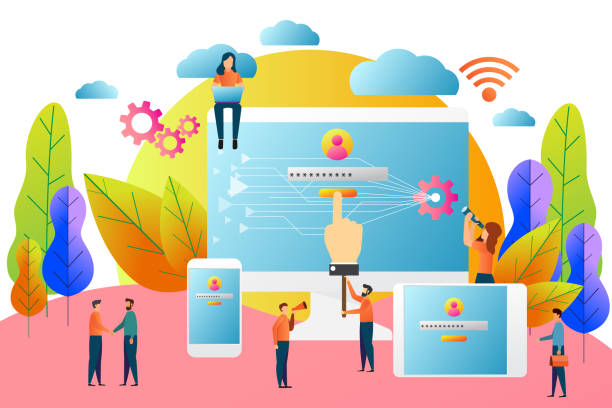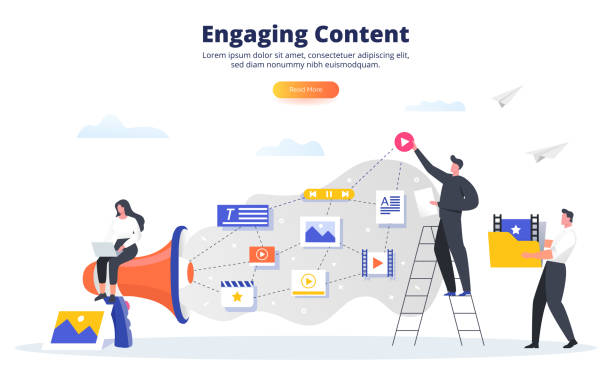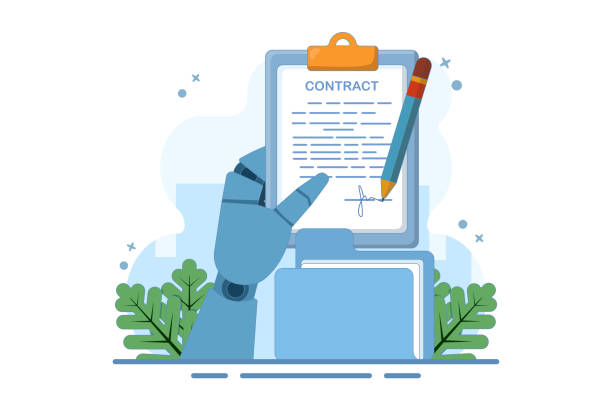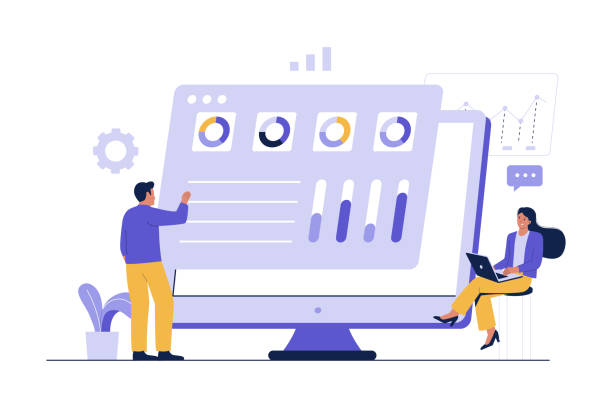Introduction to the Importance of Multilingual Website Design in the Era of Globalization

In today’s world, where geographical borders are rapidly fading, online presence and global communication are of vital importance.
One of the most effective ways to reach a wider audience globally is through multilingual website design.
This approach allows businesses and individuals to present their content in various languages, thereby significantly expanding their audience base.
Beyond mere text translation, multilingual website design involves understanding cultural differences, technical optimization for international search engines, and providing a seamless user experience for visitors from anywhere in the world.
This specialized process requires meticulous planning, selection of appropriate tools, and correct execution to unlock its full potential for business development and increased accessibility.
Undoubtedly, investing in a multilingual web platform is a strategic step for any entity seeking growth and penetration in international markets.
Are you tired of your company’s website failing to meet your expectations? With Rasawweb, design a professional website that truly represents your business.
✅ Increase acquisition of new customers and sales leads
✅ Boost your brand’s credibility and trust among your audience
⚡ Get a free website design consultation!
Countless Advantages of Multilingual Website Design for Business Growth

Multilingual website design offers significant advantages for the growth and development of businesses on a global scale.
The first and most prominent benefit is access to new markets and an increase in the number of potential customers.
When your website is accessible in the native language of your target audience, it fosters a deeper sense of trust and connection between you and them.
This translates to higher conversion rates and, ultimately, increased sales.
Secondly, multilingual websites contribute to improving international SEO.
By using the correct URL structure, hreflang tags, and keyword translation, your website gains better visibility in local search results for various languages.
Search engine optimization in multiple languages directs more organic traffic to your site.
Furthermore, offering content in multiple languages presents a professional and global image of your brand, which helps strengthen your credibility and position in the industry.
This is a long-term investment that provides immense potential for global expansion not only today but also in the future.
This analytical approach demonstrates how significant returns can be achieved in the international arena with a smart investment.
Key Challenges in the Process of Multilingual Website Design and Implementation

Multilingual website design, while offering numerous benefits, also comes with unique challenges that require meticulous planning and a specialized approach.
One of the most significant challenges is content management and ensuring the accuracy and quality of translations.
Mere word-for-word translation is not enough; content must be localized to align with the culture and linguistic sensitivities of the audience.
Another challenge involves technical issues related to international SEO, including choosing the appropriate URL structure (subdomain, subdirectory, or dedicated domain), correct implementation of hreflang tags, and managing duplicate content.
These factors are crucial for avoiding search engine penalties and ensuring site visibility in local results.
Additionally, managing the support and maintenance of a multilingual site over time can be complex, especially when new content is added or technical updates are needed.
Ignoring any of these aspects can lead to a poor user experience and the loss of international growth potential.
To overcome these challenges, collaboration with specialists and the use of powerful content management systems are essential.
Technical Aspects of Multilingual Website Design and Optimization

Technical aspects play a crucial role in multilingual website design and can directly impact the website’s performance and visibility.
One of the most important is the correct implementation of hreflang tags.
These tags help search engines display the correct version of a page for the appropriate language and geographic region.
Without these tags, search engines might consider translated content as duplicate content and harm your site’s ranking.
Choosing a Content Management System (CMS) is also particularly important; CMSs like WordPress with multilingual plugins such as WPML or Polylang, or Drupal and Joomla, provide easy management of translated content.
Furthermore, website loading speed in different regions of the world must be considered.
Using a Content Delivery Network (CDN) can help reduce loading times for users worldwide.
Ensuring Right-to-Left (RTL) support for languages like Persian and Arabic is also an essential aspect that should be considered during the initial design phase.
These technical considerations form the backbone of a successful multilingual website.
This educational section emphasizes the importance of technical tools and correct settings to achieve the best results.
Unhappy with your e-commerce site’s low sales?
Rasawweb is your solution for a professional and high-selling e-commerce site.
✅ Significant increase in sales and revenue
✅ Easy and enjoyable shopping experience for customers
⚡ Get a free consultation from Rasawweb now!
Effective Strategies for Content Translation and Localization

Beyond mere literal translation, effective strategies for content localization in multilingual website design ensure the success and effectiveness of communication with international audiences.
Localization means adapting content to the culture, values, idioms, and even currency and measurement systems of the target region.
This includes professional translation by native speakers, not just using machine translation tools, and meticulous content review to ensure accuracy and cultural appropriateness.
Furthermore, special attention should be paid to visual content; images, videos, and graphics must align with the cultural sensitivities of the audience and prevent potential misunderstandings.
In some cases, there is even a need to completely rewrite content for specific markets.
This approach ensures that your message is conveyed correctly and resonates with the target audience.
This guidance section emphasizes that the quality of content translation and localization is the backbone of a successful multilingual website.
The difference between translation and localization can be considered the main key to understanding this process.
Search Engine Optimization (SEO) for Multilingual Websites

Search Engine Optimization (SEO) in a multilingual website is a specialized and complex field that requires great precision.
Mere content translation and hreflang tag implementation are not enough.
To achieve high rankings in international search engines, research-backed and optimized keywords for each language must be considered.
This means that a keyword effective in Persian might not have an exact equivalent or might have fewer searches in English or Spanish; therefore, local keyword research for each language and geographic region is essential.
Furthermore, technical issues such as website loading speed for a global audience, responsive design for various devices, and an SEO-friendly URL structure must be considered.
Internal linking between different language versions can also help transfer page authority and improve rankings.
Finally, continuous monitoring of SEO performance in each language and making necessary adjustments based on analytical data are crucial for maintaining long-term rankings.
This process requires deep knowledge of search engine algorithms and the specific needs of each local market.
The Importance of User Experience (UX) in Multilingual Website Design

User Experience (UX) plays a vital and central role in multilingual website design.
A successful multilingual website must not only offer content in different languages but also ensure that visitors from every culture have a smooth and intuitive user experience.
This includes User Interface (UI) design that is easily navigable and clearly visible language-switching options.
The placement and design of the language selector should allow users to quickly choose their desired language, preferably in a fixed and accessible location (such as the header or footer).
Furthermore, attention must be paid to text direction (RTL for languages like Persian and Arabic), fonts, colors, and icons to match the cultural norms and readability of each language.
Page loading speed and optimization for mobile devices are also key UX elements that must be maintained across all language versions.
A poor user experience can lead to quick user exits and damage to brand reputation, even if the content is accurately translated.
Common Mistakes and Challenges in Multilingual Website Design and Their Solutions

In the process of multilingual website design, there are common mistakes that can harm your efforts and should be avoided.
One of these mistakes is machine translation without human review.
Although machine translation tools have advanced, they can never accurately capture cultural nuances, local idioms, and appropriate tone.
The solution is to always use native and professional translators and review the translated content.
Another mistake is neglecting international SEO; many believe that mere content translation is sufficient, whereas SEO optimization for each language requires independent keyword research and correct implementation of hreflang tags.
Also, the inability to manage new content or continuous updates can lead to inconsistencies between language versions.
These challenges can make the website questionable in the eyes of the audience.
To solve this problem, it is essential to use a robust content management system with multilingual capabilities and to establish a consistent process for content translation and updates.
Finally, insufficient testing of the website across different languages and browsers can lead to technical issues and a poor user experience.
How much do unprofessional websites cost you in lost business leads? Solve this problem forever with professional corporate website design by Rasawweb!
✅ Increase credibility and trust of potential customers
✅ Easier acquisition of new business leads
⚡ Get a free consultation now!
Useful Tools and Platforms for Multilingual Website Design

To facilitate the multilingual website design process, numerous tools and platforms are available that can assist you with content management, translation, and optimization.
Popular Content Management Systems (CMS) like WordPress with plugins such as WPML and Polylang, Drupal, and Joomla offer powerful multilingual capabilities.
These plugins facilitate easy management of translated content, switching between languages, and implementing hreflang tags.
For translation project management, tools such as OneSky, Lokalise, and Crowdin, as Translation Management Systems (TMS), simplify collaboration between teams and translators and ensure high-quality and timely translations.
Furthermore, for analyzing site performance in different markets, Google Analytics and Google Search Console are essential tools that provide valuable information regarding traffic, keywords, and user behavior in each language.
Awareness of these news and updated tools can help you choose the best solution for your project’s specific needs and make the multilingual website design process more efficient.
The Future of Multilingual Website Design and the Role of Artificial Intelligence

The future of multilingual website design is strongly linked to advancements in Artificial Intelligence (AI) and Machine Learning (ML).
AI has the potential to transform how content is translated, localized, and managed.
Neural Machine Translation (NMT) systems are continuously improving and can provide higher-quality translations that are closer to human translations.
This can significantly reduce translation time and cost.
Furthermore, AI can assist in international SEO optimization by analyzing large data and identifying user behavior patterns across different languages.
Content personalization based on language, geographic location, and even user preferences will become more accurate and efficient thanks to AI, elevating the user experience to a new level.
These technologies can also play a role in identifying new linguistic needs and providing automated solutions for developing multilingual websites.
Therefore, multilingual website design will transform into a more dynamic and intelligent field, further enabling global communication.
This engaging section delves into the exciting future of this field.
Frequently Asked Questions
| Question | Answer |
|---|---|
| 1. What is multilingual website design? | The process of creating a website whose content is available in multiple languages so that users from around the world can interact with the site in their own language. |
| 2. Why should we make our site multilingual? | To expand the market, attract international audiences, improve SEO in global search results, and increase brand credibility and professionalism. |
| 3. What are the methods for implementing a multilingual site? | Using subdomains (e.g., fa.example.com), subdirectories (e.g., example.com/fa/), URL parameters (e.g., example.com?lang=fa), or country-specific domains (e.g., .ir, .de). |
| 4. Is multilingual site SEO different? | Yes, it requires international SEO strategies such as using hreflang tags, an appropriate URL structure for each language, and keyword research for each language. |
| 5. What considerations should be made when choosing languages? | Language selection should be based on the target market, audience demographics, and current website traffic analysis data. |
| 6. What are the common problems in multilingual website design? | Problems related to SEO, translation quality, content management, Right-to-Left (RTL) and Left-to-Right (LTR) support, and user experience. |
| 7. What is the role of CMS in multilingual sites? | Modern Content Management Systems (CMS) (such as WordPress with multilingual plugins or Drupal) offer powerful built-in features or plugins for easy content management in multiple languages. |
| 8. How should content translation be done? | Translation should be done by native and professional translators, not just machine translation, to ensure local tone, culture, and idioms are respected. |
| 9. How is language switching done on multilingual sites? | Typically, a Language Switcher is used in the site’s header or footer, allowing users to easily select their desired language. |
| 10. Is responsive design important for multilingual sites? | Yes, responsive design ensures that the site is displayed correctly on any device (mobile, tablet, desktop), which is crucial for international user accessibility and SEO. |
And other services of Rasawweb Advertising Agency in the field of advertising
Smart Advertising Campaign: Designed for businesses seeking digital branding through user experience customization.
Smart Digital Branding: A combination of creativity and technology to increase click-through rates by customizing user experience.
Smart Marketplace: A fast and efficient solution to increase website traffic with a focus on intelligent data analysis.
Smart Direct Marketing: A fast and efficient solution to increase click-through rates with a focus on precise audience targeting.
Smart Social Media: A creative platform for improving customer behavior analysis with precise audience targeting.
And over a hundred other services in the field of internet advertising, advertising consulting, and organizational solutions
Internet Advertising | Advertising Strategy | Advertorial
Sources
Advantages and Principles of Multilingual Website DesignMultilingual Website Design: Principles, Advantages, and SolutionsMultilingual Website Design: A Complete Guide to Creating a Successful WebsiteMultilingual Website Design and Everything You Need to Know
? With Rasawweb Afarin, transform your business in the digital world! From professional WordPress website design to powerful SEO and social media management, we are with you to shine at your peak.
📍 Tehran, Mirdamad Street, next to the Central Bank, Kazeroun Southern Alley, Ramin Alley, No. 6

